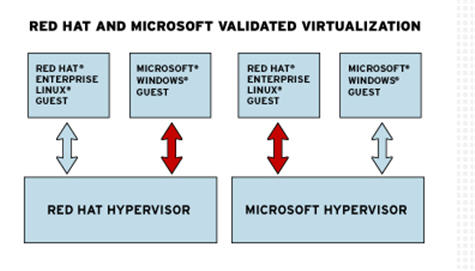The Red Hat and Microsoft pact: A nice win for mixed source shops; Frenemies vs VMware

Red Hat and Microsoft have teamed up on a virtualization interoperability pact that's a big deal for customers--especially the mixed source variety--and a potential worry for VMware.
The announcement, which landed Monday, has a few moving parts, but the big takeaway is that each company will validate and certify each other's virtualization software and coordinate technical support. That's a nice win for customers that are increasingly going mixed source with Linux and Windows servers in their data centers.
Here's what you need to know:
- Red Hat and Microsoft customers will run Windows Server and Red Hat Enterprise Linux virtual servers on either environment with configurations tested by both sides. Red Hat will validate Windows Server guests and Microsoft will reciprocate so that Red Hat Enterprise Linux servers will be supported on Windows Hyper-V. Matt Asay notes that the Red Hat-Microsoft pact "is a major win for customers."
- Technical support will be coordinated. Microsoft's Peter Galli adds that the deal "will allow customers to monitor end-to-end data center applications that are distributed across both Windows Server and RHEL, whether these servers are physical or virtual."
- There are no patent, intellectual property or licensing fine print between the two sides. IP is what had the open source community screaming about the Microsoft-Novell pact. Mary Jo Foley explains:
To be clear, the newly minted Microsoft-Red Hat partnership is not the same as the Microsoft-Novell one that Microsoft unveiled two years ago. There is no patent-protection clause that is part of the new Microsoft-Red Hat agreement, meaning Red Hat has not agreed to license any Microsoft patents in the name of guaranteeing its customers that Microsoft won’t sue them for possible patent infringement. No support certificates for Red Hat Enterprise Linux (RHEL) will be sold by Microsoft, either.
While there are a few quibbles about the Microsoft-Red Hat pact it's hard not to come away positive on the deal.
The two parties haven't set a date for availability yet.
Target: VMware
Although the nuts and bolts of the Red Hat-Microsoft are straightforward, the impact on VMware isn't. One thing is clear: Red Hat and Microsoft have two virtualization technologies that are both aiming to upend VMware's dominance. Microsoft has Hyper-V and Red Hat Enterprise Linux has virtualization built in.Mike Neil, general manager of virtualization at Microsoft, writes on his blog:
Ever since we released Windows Server 2008 Hyper-V and Terminal Services, System Center Virtual Machine Manager 2008 and Microsoft App-V 4.5 last year, customers and partners have been getting huge value from server consolidation projects, have been able to increase business continuity at much lower costs than with VMware, and have decreased the time and cost required to deliver applications to end users. And while doing this, they’ve been able to use a familiar set of system management tools for both their virtualized and non-virtualized systems and applications across the datacenter and desktops. In fact, Chris from Kroll Factual Data wrote about his DR project on this blog last year.
Neil didn't even finish his first paragraph before he threw a jab at VMware. Red Hat is more than happy to join the fray. The enemy of your enemy is your friend.
Also see: Microsoft Hyper-V to VMware: We have you surrounded
